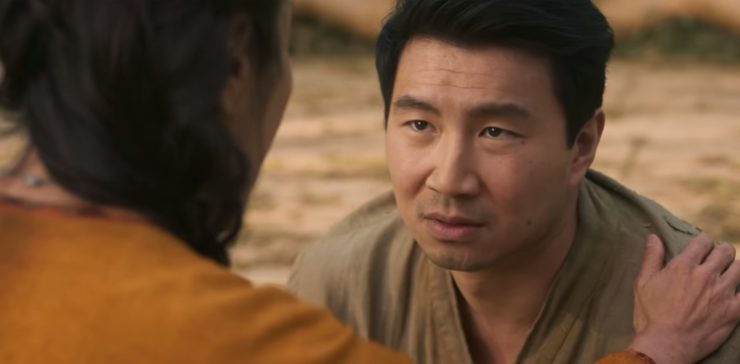The Marvel Cinematic Universe is known for borrowing a dash of flavor from other films or genres. Captain America: Winter Soldier draws some of its feel from the paranoid political thrillers of the 1970s. The MCU Spider-Man movies take some cues from the teen comedies of John Hughes. The Ant-Mans (Ant-Men?) pilfer from various capers. Shane Black’s Iron Man 3 is a Shane Black movie. They aren’t exact copies, but the influences are there if you look for them.
It’s unavoidable that Shang-Chi and the Legend of the Ten Rings would emulate the forms of martial arts cinema, and more overtly than the spiritual kung-fu movie Doctor Strange. What I found interesting was the mix of martial arts subgenres at play. There’s Jackie Chan-inflected Hong Kong action, nods to period kung-fu movies of the 70s and 80s, wuxia romance, and blockbuster fantasy that wouldn’t be out of place in Tsui Hark’s filmography.
At times, Shang-Chi feels likes a history of movie watching for Asian-American kids of a certain age.
[Major Shang-Chi spoilers below]
***
My first martial arts movie was Infra-Man (The Super Inframan). It was basically a Chinese superhero movie, and also a hybrid: a Shaw Brothers riff on Japanese tokusatsu shows like Ultraman and Kamen Rider.
Rayma (Danny Lee, much later of The Killer fame) is turned into a solar-powered cyborg to battle a prehistoric demon called Princess Dragon Mom (Terry Liu); she resides in a retro-tech volcanic lair with Jim Steranko accent walls. Infra-Man fights a hissing plant monster, a sci-fi witch with eyes in the palms of her hands, spring-loaded robot twins, and an army of skeleton warriors with exploding spears. He can fly, and shoot Thunderball Fists, and do sparking jump kicks. Infra-Man can also grow really big—kaiju size—but he only does it once, and only because an evil orange bug monster did it first.
At age five, it was the best movie I’d ever seen. (Sorry, Chitty Chitty Bang Bang.) I would wear down that taped copy of the English dub of the film, and draw Infra-Man in crayon, and play Infra-Man with my younger brother.
At one point of the film, a young girl is so inspired by the heroism of Infra-Man she says one day in the future she wants to be Infra-Girl.
***
The bus scene in Shang-Chi is one of the best fights in the MCU. It uses the environment in such dynamic ways; characters move out of, back into, and through the bus with remarkable fluidity. The sequence was blocked, choreographed, and shot over the course of a year, and all of the hard work from the stunt crew and performers leads to an absolute showstopper early in the film.
The bus fight’s rhythms and movements are bound to draw comparisons to Jackie Chan, particularly Police Story and New Police Story. The way Shang-Chi (Simu Liu) leaps and dodges between the rails and seats also feels a little like the playground fight in Police Story II.
The action in Shang-Chi was overseen by two former members of the Jackie Chan Stunt Team: fight coordinator Andy Cheng, and supervising stunt coordinator Brad Allan, who passed away earlier this year at age forty-eight.
Cheng has worked on both sides of the camera, which includes doubling for Chan in a few of his films from the late 90s and early 2000s. Prior to Shang-Chi, his most notable action director credit was the underappreciated Into the Badlands. It will be fascinating to watch how he tries to top himself in the inevitable Shang-Chi sequel, though more on that a bit later.
Cheng’s mentioned in a few interviews that the bus scene wasn’t meant to be an homage to Jackie Chan, and yet it has so many Chan-esque hallmarks.
Shang-Chi begins the scene saying “I don’t want any trouble,” which is Jackie Chan 101: Introduction to a Jackie Chan Fight. There’s a mid-melee flourish in which Shang-Chi removes and puts on his jacket between punches and elbows, a bit of flair (Jackie Chan 210: Aesthetics in the Performing Arts). Later, after accidentally destroying a passenger’s laptop, he apologizes (Jackie Chan 330: Social Ethics).
Allan was the first non-Asian member of the Jackie Chan Stunt Team, and something of a protege to Chan himself. The Australian actor’s standout on-screen credit is in Gorgeous. He fights Jackie one-on-one in that film. Twice. Allan is so nimble and compact, and the best foil for Chan since Benny “The Jet” Urquidez (see Wheels on Meals and Dragons Forever). Allan’s extensive action design and choreography credits include Hellboy II, Scott Pilgrim vs. The World, Kick-Ass, Pacific Rim, The World’s End, and the Kingsman franchise.
If you stick around through the end credits of Shang-Chi, you’ll notice that the movie is dedicated to Brad Allan.
***
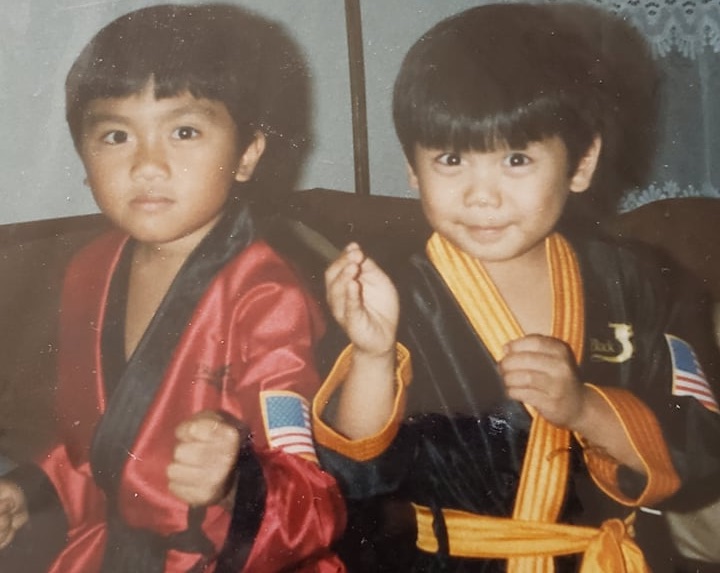
Not long after my Infra-Man obsession, I got really into Bruce Lee. How could I not? It was the 1980s; Bruce Lee was the most prominent model of Asian masculinity in American pop culture at the time. The dude even fought Batman and Robin.
My parents still have photos of me, maybe at the cusp of age six, standing on our living room coffee table striking awkward Jeet Kune Do poses. I’m dressed in decidedly un-Bruce-Lee attire: a long-sleeved flannel shirt, a sweater vest, slacks, and a clip-on bow tie. I looked like I was invading a meeting of the Young Republicans. (My mom couldn’t find those photos, so please settle for a picture of my brother and me one Halloween.)
In show and tell in first grade, one of my classmates brought nunchucks. Ms. Betz asked if anyone knew how to use them. I raised my hand, went to the front of the classroom, took hold of the nunchaku, and proceeded to do my best Bruce Lee, which was very bad. I hit myself in the back of the head by accident and the class laughed; maybe with me, mostly at me.
***
The Macau skyscraper fight feels like a nod to Project A Part II and Rush Hour 2, which both feature sequences with bamboo scaffolding. Like the bus fight, the scene plays out in narrow confines. Rather than a small horizontal space, the scaffold changes the battle field into confined vertical and horizontal spaces. The playfulness of the bus scene is gone. There’s a sense of escalating danger, and it sets a different tone for the sequence at this point of the film. Each fight tells a story.
There’s another element to Chan-esque action design that comes into play here: saving defenseless allies at any cost. Shang-Chi tells his friend Katy (Awkwafina) to escape while he holds off hordes of disposable goons from the Ten Rings. Katy doesn’t get away easily, which means Shang-Chi has to figure out how to protect his friend.
I think this started to become a trope in Chan’s films around Armour of God. Toward the end of that movie, Chan distracts a roomful of evil monks (think Franciscan, not Shaolin) so his two hapless pals can make a getaway. Exits are closed off, plans change, our heroes have to improvise, and a new gag is set up in motion. Action-reaction-setup ad nauseam, all in service to heightening drama, comedy, and spectacle.
There’s an ornate construction to many classic Jackie Chan fights, and his imagination is his greatest asset. Every object that’s ready at hand can become a weapon, or an obstacle, or a distraction (Jackie Chan 455: Phenomenology). Complexity and novelty are just two aspects of his fights, though. In Jackie Chan: My Stunts, a documentary that chronicles and dissects his action filmmaking philosophy, Chan takes a moment to play with props around his stunt team. There’s one emphatic word that keeps leaving his mouth that sticks in my mind: “Pretty.”
***

In high school, I made my own Jackie Chan-style short film with a camcorder. For some reason I was trying to steal a porcelain bunny that my friends worshipped like a god. I did not know any martial arts, and it showed. I had watched a lot of Jackie Chan movies, however, and did my best to mimic his movements, including the iambic meter of his early films, like Drunken Master, The Fearless Hyena, and The Young Master. Like a lot of teenage art, it was a crummy noble effort; I kicked like I was struggling to put on jeans.
The only highlight, apart from my mortifying attempt at drunken boxing, was a stunt that could have gone awry. To escape the bad guy headquarters (i.e., my parent’s house), I snuck out of a second-floor window and jumped off the roof into the backyard. I did not know how to take a fall, and it showed.
When I hit the ground, my legs gave out from under me. I crumpled into a ball, and the underside of my chin came straight down onto my knees. To this day that’s the hardest I’ve ever been hit, and it was me hitting myself. Concussed and prone on the wilted grass, I stared dazed into the camera before my friend cut the shot. I probably would have bitten off my own tongue if I was more reckless.
I tried to make another kung-fu short that summer. It was never finished; it barely started. My friends, who had humored me after school so many times for the previous movie, were bored with this one from the outset. We shot for one afternoon and never spoke of it again. They probably spared me a broken ankle. My heroes.
***
From the outset, it’s evident that Shang-Chi has a deep love for wuxia films. I sensed a particular affinity for a trio of early 2000s releases: Zhang Yimou’s Hero and House of Flying Daggers, and Ang Lee’s Crouching Tiger, Hidden Dragon. All of those movies owe heavily to the pioneering work of King Hu, who made three genre-defining wuxia films starting in the 1960s: Dragon Inn, Come Drink with Me, and the sprawling A Touch of Zen.
At the beginning of Shang-Chi as Wenwu (Tony Leung) tries to access the magical village of Ta Lo, he’s confronted by Ying Li (Fala Chen). They do battle. His style is forceful, hers more flowing, a mix of Tai Chi (of course) and Baguazhang. He strikes, she recedes and ripostes. He’s outclassed. Mid-battle as Wenwu and Ying Li draw closer, they swoon in slow motion. It’s a blow to the heart, and dancelike—he’s lost and doesn’t mind.
It’s a familiar trope in martial arts movies in general: acknowledging prowess gives way to a sense of connection, and potentially attraction. Shang-Chi seems to make an overt nod to Leung and Zhang Ziyi’s fight in Wong Kar-Wai’s The Grandmaster. Also think of Ziyi’s heated desert tête-à-tête with Chang Chen that seeds Crouching Tiger, Hidden Dragon’s romance. And there’s that erotic charge between Brigette Lin and Leslie Cheung in Ronny Yu’s The Bride with White Hair, chasing after one another in flight in the treetops. Cheung later removes a poisoned barb from Lin’s shoulder blade using his teeth, and then sucks the poison from her wound, pausing as if he intends to trace his lips along the arcing stem of her neck.
What is it about fighting someone in these films that paves the way for romance? It takes its own form in non-combat dramas and comedies as well; these two hate seem to each other, but they’re also crazy about each other. (Imagine Hepburn and Tracy in a wuxia movie.) In martial arts cinema in particular, there seems to be a moment during these fight seductions when high-minded ideals surrounding duty and social standing give way to matters of appetite, emotion, and body; even if only briefly, just in the pause between blows.
There’s so much online discussion about how sexless modern movies are, and the MCU in particular. (Admittedly, I like that Shang-Chi and Katy are just friends in this film, but I also assume most platonic male-female relationships are doomed to romance in movies, especially in a sequel.) Maybe there should be more flirty fighting in this vein in movies; and not just the adolescent attraction variety, but full of desire. What is a cinematic fight (philosophically speaking) if not an external manifestation of a person’s passion?
Nah, there should be more sex too.
***
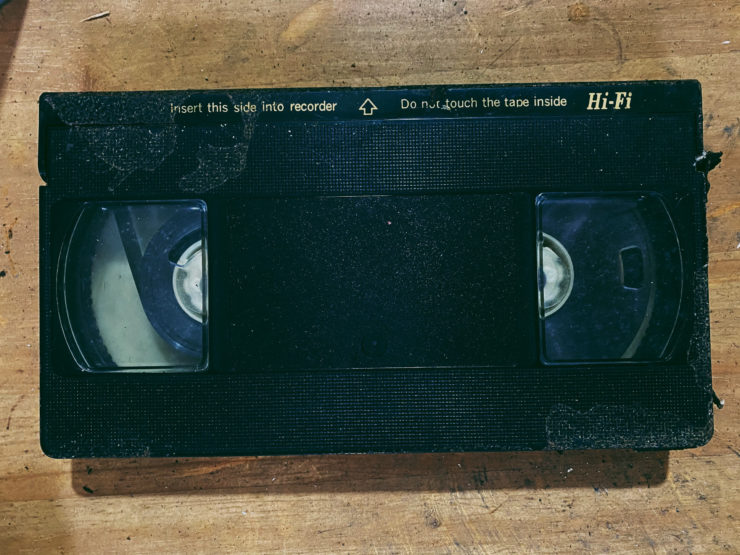
It was harder to see Hong Kong movies in the ’90s if you didn’t live in a big city. At least I grew up in the Bay Area, and there were a good amount of Asian video stores in the South Bay. Surprisingly, a local Blockbuster Video carried a copy of Police Story before New Line Cinema put it on home video; the mom and pop store where I rented Cemetery Man and Evil Dead II every month also had Dragon Lord. Many of my friends and classmates were Chinese, Korean, or Japanese, which is something I took for granted until my cultural otherness became more apparent in college.
Most of my Hong Kong cinema diet came from trades with friends (e.g., Drunken Master II ripped from a LaserDisc, God of Gamblers off a VCD), taping Jet Li movies off some unknown network on basic cable, stops at the Chinese video store after getting groceries with my mom, and special orders when I got a job at Suncoast in the mall. How many Tsui Hark and Sammo Hung movies did our store request via microfiche? Did our abuse of that system accelerate the demise of Sam Goody?
What I couldn’t find or didn’t want to hunt for, I’d read about. Pre-internet, the book Sex and Zen & A Bullet in the Head was my teenage entry-point into a larger cinematic world, much like the way Maitland McDonagh’s Broken Mirrors/Broken Minds got me into Dario Argento before I could find a copy of Suspiria.
Somewhere in this lifelong love of martial arts movies, my love of reading got tangled in too. An endless pursuit of images and words, and a connection with other enthusiasts (dorks, really). A way of being in my own head, but also with others.
***
Shang-Chi also draws some of its inspiration from Shaw Brothers classics of the 1970s and the early output from Golden Harvest. In one a flashback to Shang-Chi’s training, we watch him molded into a killing machine like something out of The 36th Chamber of Shaolin. (Since he’s just a kid, I can’t but think of Painted Faces.) Training scenes are one of the joys in great kung-fu films. We watch an accelerated climb toward mastery as our hero grinds for experience. Maybe these sequences reinforce the idea that our own practice in daily life will be worthwhile.
Our heroes may be continually punching a wooden post like Shang-Chi, which reminds me of Hsiao Ho toughening his fingers, knuckles, and wrists against tree trunks in Mad Monkey Kung Fu. There are also banal activities that build expertise, like the restricted hand movements when constructing a bamboo scaffold in Return to the 36th Chamber, or the way Yuen Biao wrings out laundry and hangs it to dry in Yuen Woo-Ping’s Dreadnaught. Whatever you do is an expression of intent, and these expressions have meaning.
Both the 1984 and 2010 Karate Kid films play with this trope on finding meaning in the the mundane. In the original, it’s the muscle memory of waxing cars and sanding floors that serve as the basis for Miyagi-Do Karate. In the newer film (nevermind its misnomer title), Jackie Chan teaches Jaden Smith about jackets, and explicitly states the thesis of dedicated marital artists: “Everything is kung-fu” (Jackie Chan 501: Ontology).
There are several classic weapons from Chinese martial arts weaved throughout Shang-Chi. The Ten Rings worn round Wenwu’s forearms are like a souped-up version of the iron rings that martial artists used to strengthen their strikes. The henchmen of the Ten Rings organization favor hook swords, which are a classic weapon in Chinese martial arts.
My favorite weapon in the movie belongs to Shang-Chi’s sister, Xu Xialing (Meng’er Zhang): the rope dart. It’s such a difficult weapon to wield, which demonstrates her unique mastery and a fighting style based on momentum and keeping distance. The weapon first came to my attention thanks to Michelle Yeoh in Magnificent Warriors. Yu Rongguang uses a chain variant in the great Iron Monkey (my introduction to Donnie Yen). We also see Jackie Chan makes an improvised rope dart with a horseshoe and lasso in Shanghai Noon.
Later in the village of Ta Lo, Xialing wields a combination rope dart and meteor hammer. What a fascinating combination: a quick piercing attack on one end and a heavy bludgeon on the other. Opposites, like her mother and father, but in one weapon, like Shang-Chi merging the styles of his mother and father to become his own master. Well, sort of.
***
It’s odd that I know way more about action movies from Hong Kong and Mainland China than I do about Filipino art and culture. Maybe it’s not so odd as a first-generation Filipino-American. My parents wanted my brother and me to assimilate into American culture, so we never learned the language (two languages, actually, since my parents speak both Tagalog and Ilocano). Mom and dad worried we’d develop an accent and wind up in ESL.
Up until college, the only Filipino movie I’d seen was part of a Dolphy comedy, or at least I think it was a Dolphy comedy. He’s the only Filipino actor my dad mentioned to me growing up. I remember two scenes:
- Two guys are in a dojo wearing karate gis. They strain to channel their inner strength. One of them pushes so hard that he soils himself. I remember my dad looking at me and laughing, and I laughed back; the language of crapping your pants is universal.
- The movie is live-action, but at some point it switches to animation, with a character singing “Somewhere Out There” from An American Tail in a warbly, Chipmunk-y voice. An American Tail was the first movie I saw in a theater.
One day, I hope to figure out what that movie was. Actually, no, that’s not that important. Mostly I yearn to connect to my own culture, somehow. It’s odd that in middle-age there’s a large part of who I am that still feels foreign. There are times when I feel like an Asian-American cliché.
***
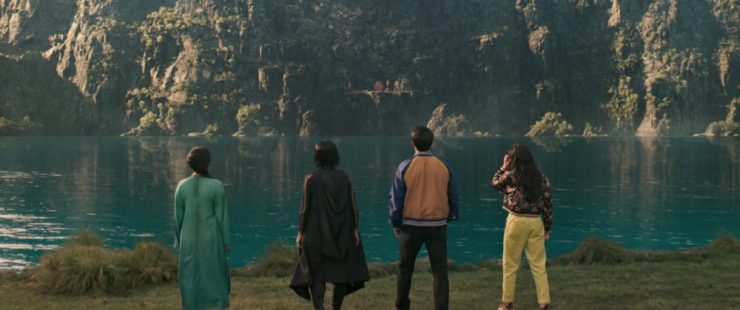
Listen, I enjoyed Shang-Chi, but I was a little letdown by the finale. I think it’s because Ta Lo felt a bit small and under-explored as a result of the overstuffed script.
We arrive in Ta Lo so late in the film that I never quite felt immersed in the mystical world; the equivalent of a ten-hour layover. Heck, Michelle Yeoh and Yuen Wah are there, and we barely get to know them. At least Yeoh’s a familiar face full of gravitas to American audiences. Wah, unfortunately, feels like he’s just an old archery instructor who gives Katy something to do in the final fight. There’s none of the meaningful master-student dynamic, and the sense of accomplishment in the training montage feels expedited rather than earned. I longed for Katy—a sidekick, a friend, an audience surrogate—to have a moment where she understands that all actions in daily life, performed with a sense of purpose, might inform a moment of mastery; the philosophy of the martial arts, not just the cool moves.
I think about Zu: Warriors from the Magic Mountain, Stephen Chow’s recent large-scale fantasy films, and even basic family crowdpleasers like Raman Hui’s Monster Hunt, and somehow those worked better for me than the last act of Shang-Chi. It’s great seeing creatures from Chinese mythology in an American film, but they feel underutilized—a dijiang reduced to toyetic cuteness, guardian lions only there to project good-boy energy, a nine-tailed fox merely used for garnish. The Great Protector is such a majestic dragon god, but I wish there was more to hold onto, that there was greater substance to the these mythological creatures on screen rather than just spectacle.
There’s also a question of creativity in the last battle. The environment played such important roles in the bus fight and scaffold fights, dynamically using horizontal and vertical spaces. The final martial arts fights in Ta Lo take place in relatively open and flat planes—a grassy area in front of the village, a nondescript rock landing under an eldritch door. The Ten Rings pull up and park their Range Rovers, and then they all fight. No sneaking, no tactics, just plopped down for a confrontation. There’s sadly no dynamic use of the village’s geography, like fights into and out of buildings, or on top of roofs. Individual conflicts don’t reach a satisfying conclusion either. Rather than having a memorable comeuppance at the hands of Shang-Chi or Xialing, the colorful Death Dealer (Andy Le) is killed by a generic eldritch creature we haven’t seen until now.
Great fights can take place in flat, wide-open spaces. Yet these fights usually take several minutes of focused action. At that point, the hero takes everything they’ve learned and applies it to their greatest foe. Yet even that knowledge has its limits. Sometimes in martial arts movies, the heroes push themselves further than their limits. In Drunken Master, Wong Fei-Hung lets go of his machismo and allows himself to embody the movements of Miss Ho. In Wheels on Meals (and Gorgeous, to an extent), our hero loosens up by treating the fight as a training session—a space to play. Happy accidents can also pave the way to victory, like the invention of the three-section staff in The 36th Chamber of Shaolin, or the unexpected revelation of a better technique a la Wing Chun. These are fighters but also artists, after all; their success is rooted in the ability to explore, adjust, and create. That sense of problem solving or personal evolution is missing from Shang-Chi’s last fights.
Maybe they ran out of time? They stopped production partway through due to COVID-19, and resumed months later. Perhaps there was a rushed shoot, with certain creative compromises to protect the cast and crew from illness. In which case, director Destin Daniel Cretton wasn’t dealing with narrow horizontal or vertical spaces, but maybe a narrow shooting schedule. Or maybe it’s the trap of the MCU final act, and some films deal with it better than others.
The underwhelming martial arts gives way to a big CG finale in which Shang-Chi and Xialing feel more like observers rather than participants. They’re so tiny on screen as the action unfolds. It’s less like a quick time event in a video game and more like the brother and sister are involved in an extended cut scene, passively watching the digital behemoths around them.
Did this movie need to conclude with a world-ending event? Wasn’t the family conflict more compelling than the threat posed by some stock eldritch horror? But how fitting: the human element of the movie, the best part of Shang-Chi, gets lost in a muddy explosion of digital effects.
***
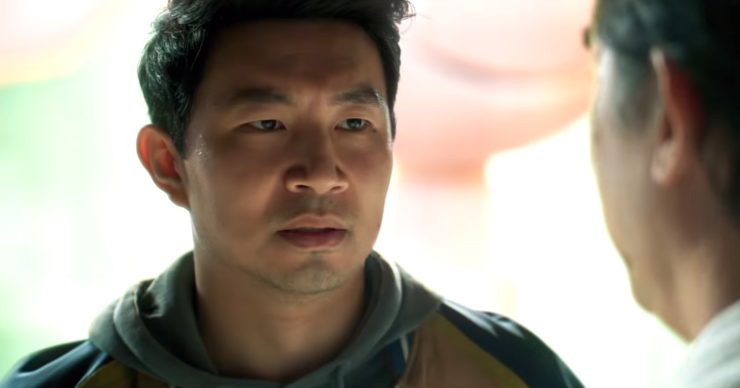
I think of the stars of martial arts movies and the heroes they play. They have such distinct personalities and styles. You can’t mistake Jackie Chan for Bruce Lee, or for Donnie Yen, or for Jet Li. Similarly, Michelle Yeoh is not Cheng Pei-Pei, or Zhang Ziyi, or Kara Hui. Every member of the Venom Mob had their own personality and style (the acrobatic goofball Chiang Sheng was always my fav).
The question I’m left with despite mostly enjoying Shang-Chi and the Legend of the Ten Rings: Who is Shang-Chi as a character? What defines his personality? What is his style? I also wonder about Xialing, who seems similarly underserved. I have a better sense of Wenwu and Katy as characters. I’m curious how Cheng (assuming he returns for the sequel) will design the action in the future. Will a distinct Shang-Chi style emerge that communicates his character? Will they get away from the nods to Chan, or is it difficult for students to avoid moving at least a little like their masters?
Maybe I’m asking too much. It’s not like Rayma from Infra-Man was complex. And yet when a movie like Shang-Chi has so much going for it and I could sense its thoughtfulness, I can’t help but hone in on its creative shortcomings in the last third of its runtime—the exposition dumps, the momentum-sapping flashbacks, the comparatively empty feeling of the finale’s action. To be fair, I’m unfamiliar with Simu Liu’s other work outside of this movie, and maybe that knowledge is meant to inform what I should make of the character. Though given what I’m learning about Liu’s online presence, maybe I’m good just sticking to the text of Shang-Chi (Jackie Chan 596: Lots of Really Bad Takes).
What I can say is that Shang-Chi knows martial arts, and he likes martial arts cinema (note the Kung-Fu Hustle poster in his room). He seems like a semi-normal Asian-American guy: an affable screw-up just trying to make rent and avoid dealing with major daddy issues.
When I put it that way, he sounds awfully familiar, but he’s a hero, and inside of me there’s a kid posing on a coffee table who wants something more.
Falling Man illustration by Mohamed Hassan used under Pixabay license.
VHS Tape image by JC Gellidon used under Unsplash license.
Hubert Vigilla is a Brooklyn-based writer whose fiction has appeared in The Normal School, No Tokens, Territory, and elsewhere. He still does not know any martial arts. You can follow him on Twitter.










